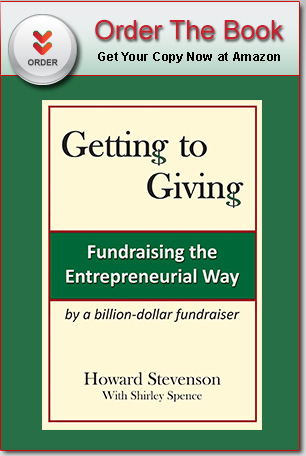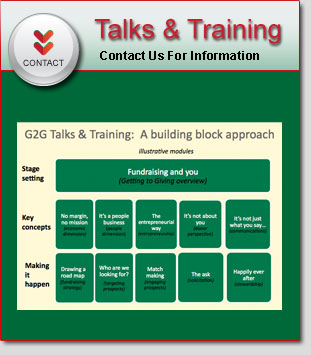The shoe story came to me as I was preparing to give a talk about fundraising at a higher education institution where I serve on the board. How could I explain to faculty and staff not involved (and, in some cases, not interested) in fundraising why it isn’t just begging?
Most people don’t think of fundraising as serving a donor’s needs, and the notion of “fit” between donors and organizations is hard to describe. My mind wandered to a recent shoe shopping experience, and I decided to use that as a metaphor for how a donor thinks.
Here’s how my story went. (I found a way to tie it into G2G’s four donor questions, of course.)
First, what kind of shoes am I looking for? Why do I want them? What function do they need to serve? The answers could range from wingtips for a job interview or high heels for a party to basketball sneakers or walking shoes.
(That would tie to “Are you doing important work?” The donor first needs to decide what cause they care about, what problem they want to solve.)
Let’s say the answer is dressy shoes. Now, where to buy them? We decide to visit the local mall. There are many options as you stroll through the four levels.
Some stores are easy to walk by; Olympia Sports, for example, doesn’t sell dressy shoes. The Walking Company’s “comfort footwear” probably won’t fit the bill either. (You may pop in though, if you see something you like in the window or spot a great sale.)
Then what? Price? Selection? Service? Your buying criteria and how you prioritize them may lead you into or out of Coach (small selection of their own, luxury brand) or Lord & Taylor (“service, quality and, most of all, style”) or or Payless Shoes (“get great deals on shoes”).
(This harkens to “Are you well managed?” Stores – and nonprofit organizations – have different business models. A shopper – or donor – needs to find one that resonates.)
You decide you want a designer look. Lord & Taylor has something that might work but not in the color you want. Nordstrom’s? A friendly salesperson helps you find another good candidate, in the color you want and that hard-to-find half size. But the price! Maybe Payless will have something.
You pop in and immediately are overwhelmed by the disheveled racks of shoes. Not likely to have something you want, you decide. You’re headed back to Nordstrom’s when you remember that there’s a DSW Designer Shoe Warehouse (“The latest shoes at great prices”) just a few miles away. Off you go.
(That sounds like “Will my gift make a difference?” It’s about the “give-get,” whether that is the right shoe at the right price or the impact you want on a cause that you care about.)
The DSW store is huge but it has attractive displays and is easy to navigate. You find something you like quite quickly, at a reasonable price. You’re not 100% sure about the color though; will they accept returns? The clerk at the sales desk assures you that would not be a problem. Success! Maybe you should check out their boots too, while you’re here…
(This one is easy: “Will the experience be satisfying to me?” A pushy salesperson, a long checkout line, a no-refund policy or a dinnertime telephone solicitation, a mistake on your donation tax receipt, lack of information about how your money is being used… there are many ways to off-put a shopper or a donor. The experience matters and will affect not only the transaction at hand but whether you remain a loyal customer.)
Here’s the feedback I got after my talk: “Thank you for taking the time to talk with us about fundraising. No one will ever forget your shoe shopping story!”
I choose to take that as a compliment. Hopefully, the message came across that that fundraising is not about begging but rather about understanding the customer and, if you have something they want, providing an easy and enjoyable opportunity to help you advance your mission.



